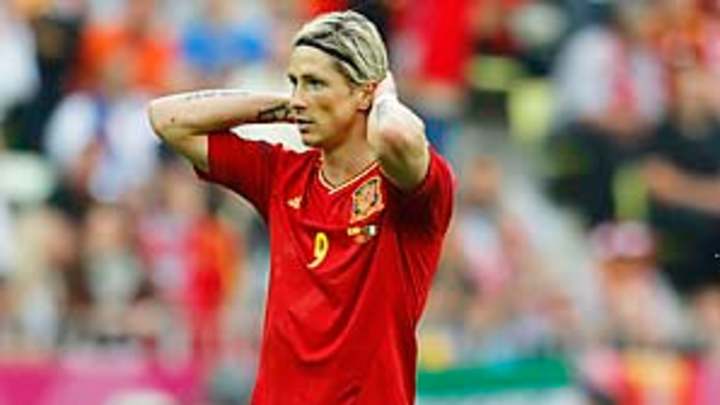Three thoughts: Spain's striker-less attack cost them vs. Italy in draw


Here are three thoughts from Spain's 1-1 draw with Italy in Group C action:
1. Spain's striker-less attack: Spain's system, a 4-3-3-0, was the most radical seen in a major international football tournament for decades. Usually the international game, because of the lack of time the players have to work together, lags way behind the club game, but this placed Vicente Del Bosque firmly in the avant-garde. Unusual systems that have been termed "strikerless" at least have a forward -- a Francesco Totti, Cristiano Ronaldo or Lionel Messi -- to drop back and create space for runners from deep while still getting forward to score goals themselves. But Spain's shape, with Andres Inietsa, Cesc Fabregas and David Silva across the nominal forward line had three players who have spent most of the season operating as orthodox attacking midfielders.
This is the shape Carlos Alberto Parreira envisaged when he spoke at a conference in Rio de Janeiro in 2003 of the formation of the future being 4-6-0.
What he foresaw was a team playing with four defenders and then six highly technical, almost interchangeable midfielders who could play with great fluidity and change the angle of attack almost at will. The danger, as Spain discovered in a friendly against England last November, when it set up with David Villa on the left, David Silva in the middle and Iniesta on the right, is that without a focal point a team can lack cutting edge. The intermovement of the midfield has to be properly directed or a team can simply end up holding possession in front of an obdurate opponent with nothing to pierce the defensive line.
That was the fate Spain suffered. Occasionally there were breakthroughs -- Silva cutting in from the right and seeing his shot saved after 11 minutes, Iniesta running on to a Fabregas through-ball and having his shot just tipped wide by Gianlugi Buffon -- but for too much of the game it lacked vertical penetration. When the equalizing goal came it was significant, when Fabregas at last manufactured room to run onto a through-ball; precisely the sort of pass into the path of a run it had previously lacked.
The introduction of Fernando Torres, a striker at last, for Fabregas with 16 minutes remaining gave Spain a much more direct threat and he may have punished a sloppy offside line on three occasions after coming on. Whether that was another to persuade Del Bosque away from his tactical vanguardism remains to be seen.
2. Italy's back three: The false nine met a false libero. Italy's three at the back had been widely anticipated, but it still represented a remarkably bold decision by Cesare Prandelli. The back three has come increasingly into vogue in Italy over the past season, with 17 of the 20 Serie A clubs using it at some stage, but it was a specifically Italian solution to a specifically Italian problem. In 2010-11, most sides in Italy played a 4-3-1-2, the cultural heritage of Italian football having left it feeling a need to pack players into central areas. That meant that in the league, games often became tight tactical battles, but in European competition, opponents delighted in the spaces on the flanks.
Even in Series A, teams that played with width -- Napoli and Udinese with their variants of 3-4-3, even Cesean with their 4-3-3 -- overperformed and that led last season to a more general shift. The Italian mindset remains to pack the middle, though, which militates against wingers; accordingly most preferred to play with a back three and wingbacks.
So in that sense, Prandelli's decision to move to a back three made sense: Christian Maggio and Emanuele Giaccherini, the wingbacks, could trouble Jordi Alba and Alvaro Arbeloa, the Spanish fullbacks, while Italy still had eight men in central areas. What was odd was the use of a midfielder, Daniele De Rossi, as the libero. Still, he was tenacious and, given the quality of Italy's first line of defence, the central midfield three of Andrea Pirlo, Thiago Motta and Claudio Marchisio, his pure defensive qualities were rarely tested -- until Torres came on. Once he had, De Rossi looked every inch a midfielder playing at the back struggling with the Chelsea forward's pace and movement.
3. Much potential: There's a great footballer in Mario Balotelli waiting to get out. Balotelli remains one of the world's most divisive players. He can be maddeningly stupid and self-destructive yet charmingly self-deprecating, volatile yet ironic, a hero and a liability. But sometimes he does things that take your breath away. His control moments before halftime, taking down a highball on the touchline, was sensational -- athletic, balletic and brilliant, the sort of first-time control, the instinctive feel for a ball that belongs to the true greats. And yet, when he dispossessed Sergio Ramos nine minutes after the break to set up a one-on-one with Iker Casillas, he dallied mystifyingly, allowing the Real Madrid defender to get back.
And his reputation doesn't help. When Casillas fumbled an Antonio Cassano shot 11 minutes before halftime and Balotelli ran onto it, he and Gerard Pique tangled. If anything the foul was by the Spaniard, but the referee Viktor Kassai of Hungary gave a free kick to Spain and warned Balotelli; sure enough, an enraged Balotelli was then fractionally late with a challenge on Sergio Busquets a couple of minutes later, and the Barca midfielder made the most of it and Balotelli was booked. Was it fair? Probably not, but if Balotelli calmed down and let his ability shine through the attitude, he might find more decisions like that going his way.
